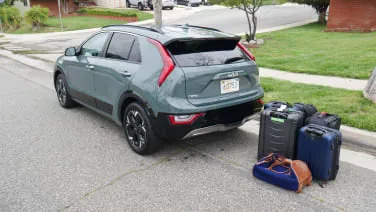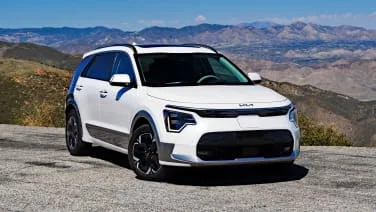2023 Kia Niro
Last week, the new Toyota Prius was brought into Luggage Test HQ and didn't exactly leave a winner. This week, we have one of its only competitors: the Kia Niro. Sure, the body style is totally different, but the number of hybrids and plug-in hybrids in this price and general size range are limited, so this is what we've got. And while I may mention the Prius again once or twice throughout, the Niro quite simply wipes the floor with it in terms of cargo capacity. The Niro grew enough for its second generation that it now aligns closely with the group of SUVs we dubbed "midcompact" because they slotted in between subcompact and compact models. Its official cargo capacity figure of 22.8 cubic-feet would put it on the low end of that subsegment, but as you're about to see, it does much better with actual stuff. There is a caveat, however. You see, the Niro is available with regular hybrid, plug-in hybrid and full electric powertrains. The hybrid and EV include a dual-level cargo floor, as many small SUVs do, to allow for maximum capacity with the rear seats raised or a flat load-floor with them lowered. The plug-in hybrid only has the higher floor height, however, because the combination of bigger battery and gas tank effectively wipes out the extra cargo depth. The result is an official capacity of 19.4 cubic-feet, which confirms that Kia is indeed counting the lower floor height with its other cargo measurement. Thankfully, however, as the difference between them all in terms of cargo space is the dual-level load floor, I could just test with both floor heights and tell you exactly how much each version of the Niro can hold despite only testing the EV. And not only any Niro EV -- this is literally my own car. On the left is the upper height, or the only way the Niro PHEV looks. On the right is the lower height. You can see that it's not a fully flat space, with a ramp of sorts at the rearmost section. I thought this would be an issue, but as it turns out, it's basically mitigated by the angle of the seatback — you can't put suitcases flush against it anyway. It would look like this < from the side. Here is a closer look at the depth, plus some storage on either side. Unfortunately, those gutters aren't removable to effectively widen the lower floor area. Here's what's under the floor. No Niro comes with a spare tire. OK, let's get to the bags. As in every luggage test I do, that means two midsize roller suitcases that would need to be checked in at the airport (26 inches long, 16 wide, 11 deep), two roll-aboard suitcases that just barely fit in the overhead (24L x 15W x 10D), and one smaller roll-aboard that fits easily (23L x 15W x 10D). I also include my wife's fancy overnight bag just to spruce things up …
Full Review
Last week, the new Toyota Prius was brought into Luggage Test HQ and didn't exactly leave a winner. This week, we have one of its only competitors: the Kia Niro. Sure, the body style is totally different, but the number of hybrids and plug-in hybrids in this price and general size range are limited, so this is what we've got. And while I may mention the Prius again once or twice throughout, the Niro quite simply wipes the floor with it in terms of cargo capacity. The Niro grew enough for its second generation that it now aligns closely with the group of SUVs we dubbed "midcompact" because they slotted in between subcompact and compact models. Its official cargo capacity figure of 22.8 cubic-feet would put it on the low end of that subsegment, but as you're about to see, it does much better with actual stuff. There is a caveat, however. You see, the Niro is available with regular hybrid, plug-in hybrid and full electric powertrains. The hybrid and EV include a dual-level cargo floor, as many small SUVs do, to allow for maximum capacity with the rear seats raised or a flat load-floor with them lowered. The plug-in hybrid only has the higher floor height, however, because the combination of bigger battery and gas tank effectively wipes out the extra cargo depth. The result is an official capacity of 19.4 cubic-feet, which confirms that Kia is indeed counting the lower floor height with its other cargo measurement. Thankfully, however, as the difference between them all in terms of cargo space is the dual-level load floor, I could just test with both floor heights and tell you exactly how much each version of the Niro can hold despite only testing the EV. And not only any Niro EV -- this is literally my own car. On the left is the upper height, or the only way the Niro PHEV looks. On the right is the lower height. You can see that it's not a fully flat space, with a ramp of sorts at the rearmost section. I thought this would be an issue, but as it turns out, it's basically mitigated by the angle of the seatback — you can't put suitcases flush against it anyway. It would look like this < from the side. Here is a closer look at the depth, plus some storage on either side. Unfortunately, those gutters aren't removable to effectively widen the lower floor area. Here's what's under the floor. No Niro comes with a spare tire. OK, let's get to the bags. As in every luggage test I do, that means two midsize roller suitcases that would need to be checked in at the airport (26 inches long, 16 wide, 11 deep), two roll-aboard suitcases that just barely fit in the overhead (24L x 15W x 10D), and one smaller roll-aboard that fits easily (23L x 15W x 10D). I also include my wife's fancy overnight bag just to spruce things up …
Hide Full Review
Hide Full Review
Retail Price
$26,590 - $34,890
MSRP / Window Sticker Price
| Engine | I-4 |
| MPG | Up to 53 city / 54 highway |
| Seating | 5 Passengers |
| Transmission | 6-spd auto-shift man w/OD |
| Power | 104 @ 5700 rpm |
| Drivetrain | front-wheel |
| Curb Weight | 3,071 lbs |
Smart Buy Program is powered by 









